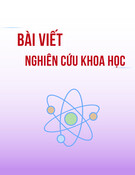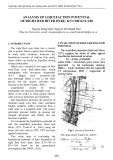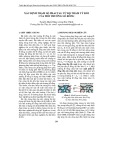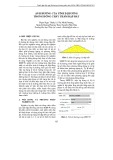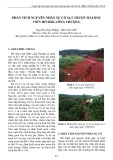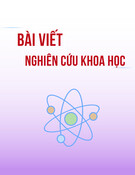
* Corresponding author.
E-mail address:sathiyaraj@drngpasc.ac.in (S. Subbaiyan)
© 2019 by the authors; licensee Growing Science, Canada
doi: 10.5267/j.ccl.2019.004.003
Current Chemistry Letters 8 (2019) 145–156
Contents lists available at GrowingScience
Current Chemistry Letters
homepage: www.GrowingScience.com
Biological investigations of ruthenium(III) 3-(Benzothiazol-2-liminomethyl)-
phenol Schiff base complexes bearing PPh3 / AsPh3 coligand
Sathiyaraj Subbaiyana* and Indhumathi Ponnusamyb
aDepartment of Chemistry, Dr. N.G.P. Arts and Science College, Coimbatore - 641048, India
bDepartment of Chemistry, Shri Nehru Maha Vidyalaya College of Arts & Science, Coimbatore - 641050, India
C H R O N I C L E A B S T R A C T
Article history:
Received September 23, 2018
Received in revised form
April 18, 2019
Accepted April 18, 2019
Available online
April 18, 2019
New ruthenium(III) complexes with 3-(Benzothiazol-2-yliminomethyl)-phenol (HL) ligand
have been synthesized and characterized with the aid of elemental analysis, IR, electronic, and
electron paramagnetic resonance spectroscopic techniques. The binding mode of the ligand
and complexes with DNA and their ability to bind DNA have been investigated by UV-vis
absorption titration. In addition, the ligand and complexes have been subjected to antioxidant
activity tests which showed that HL and its ruthenium(III) complexes possess significant
scavenging effect against DPPH and OH radicals. Cytotoxic activities of the ligand and
ruthenium(III) complexes showed that the ruthenium(III) complexes exhibited more effective
cytotoxic activity against HeLa and MCF-7 cells than the corresponding ligand.
© 2019 by the authors; licensee Growing Science, Canada.
Keywords:
Ruthenium(III) complex
Schiff base
DNA-binding
Scavenging activity
In vitro cytotoxicity
1. Introduction
It is familiar that medicinal inorganic chemistry is a multidisciplinary field combining elements of
chemistry, pharmacology, toxicology and biochemistry. Transition metal complexes that are able of
cleave DNA under physiological environment are of attention in the development of metal-based
anticancer agents.1-3 In this framework, platinum-based chemotherapy agents have been extensively
used in the last 40 years in the treatment of various cancers.4,5 Owed to the firm side effects that
platinum-based agents reveal, interest in chemotherapeutic agents has shifted to non-platinum metal-
based drugs. This is a thrust to inorganic chemists to extend inventive strategies for the preparation of
more successful, less toxic, target specific and preferably non-covalently bound anticancer drugs. Many
studies put forward that DNA is the chiefly intracellular target of antitumor drugs, because the interface
between small molecules and DNA can cause DNA damage in cancer cells.6,7 In the recent years, the
delve into on ruthenium compounds in sight to their cytotoxic properties has augmented, motivated by
the shows potential results previously obtained in both inorganic and organometallic fields where the
cytotoxicity reported for some of the compounds is similar or even improved than that of cisplatin.8 In
addition, it has been confirmed that free radicals can damage lipids, proteins and DNA of bio-tissues,
foremost to greater than before rates of cancer and auspiciously antioxidants can avert this damage due
to their free radical scavenging activity.9 Moreover, Schiff bases in concert with various metals have
been widely used as building blocks to produce great diversity of topologies. Among them, 2-





